THINGS TO DO
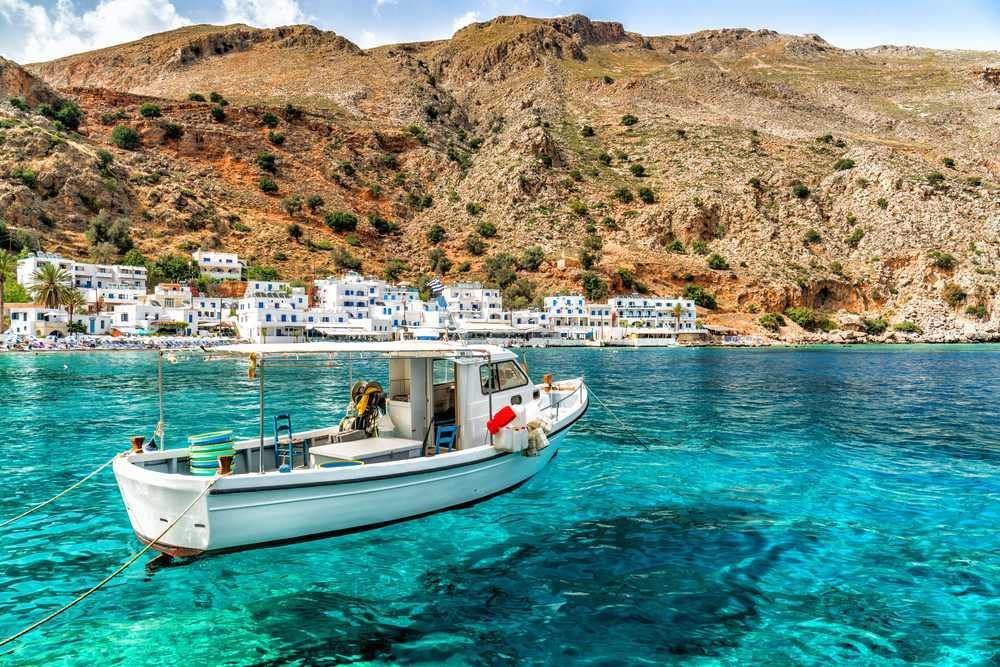
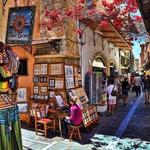
RETHYMNO
Rethymno is on the northern coast between the regions of Chania and Heraklion. It is a charming Cretan city with a stunning Old Town full of beautiful alleyways. The city was also a key center both during the Venetian and the Turkish rules of the island, therefore, some of the buildings you will see during your visit keep the characteristic traits of both cultures. It is home to an important university that gives the city a young spirit most of the year. Students from all over Greece move to Rethymno to study Philosophy, Social Sciences, and Education. Compared to Chania, it’s quieter, but the fact that so many people only come for a day trip means that nighttime allows you to wander the streets without much fuss and sit down at a cafe without a wait. For shopping (particularly for souvenirs/leather goods), the prices here some of the best than for similar goods elsewhere on Crete and far better than Athens or Santorini.
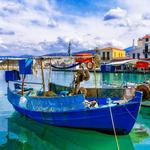
RETHYMNO | OLD TOWN
The cobbled streets of Rethymno's car-free old town takes you back through the centuries. Wandering the streets is half the fun of visiting this town. Chances are you'll find a cute café or restaurant, either in the streets or along the waterfront, and settle in for a bit of people watching. The mix of architectural styles reflects the town's history. Porta Guora is the main gate to the old town. It is the only remaining structure from the 16th-century walls arching over the narrow street below. The Venetian Harbor is one of the most charming areas of the entire town. Calm, crystal-clear water, small boats tied up, and schools of fish always looking for a handout make for a postcard perfect setting. On the far side of the harbor stands a 13th-century breakwater, and at the far end is a 17th-century lighthouse. Surrounding the harbor is a wonderful assortment of restaurants serving traditional Cretan cuisine. At night, the area is tastefully lit and a perfect spot for dinner.
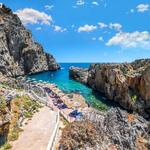
RETHYMNO | BEACHES
Rethymno Beach This is just a short stroll from Old Town that extends east along the coast. Everything you need is here- beach umbrellas, lounges, and shallow warm water. Platanes Beach Located less than three miles from Old Town Rethymno. It is easily accessible via city bus and offers beach chairs and umbrellas and plenty of hotels, cafes, and tavernas. Stavromenos Beach This small village is home to a quiet strip of golden sand that rarely gets crowded. Umbrellas and beach chairs are available for use. The town also features several tavernas serving authentic Cretan food and drinks. Bali Beach This beach has four in one- Livadi, Karavostasi, Bali, and Varkotopos. All are of very similar quality and organized with umbrellas and sun beds. Bali also offers plenty of water sport activities.
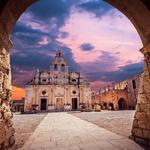
RETHYMNO | HISTORICAL SITES
Archaeological Museum of Rethymno Holds a variety of historical treasures from the city and surrounding area. Well worth a quick stop, you'll see items from Neolithic, Roman, and Minoan times. Also on display is a collection of jewelry and coins, along with Roman statues. Holy Monastery of Arkadi Holds particular significance in the island’s history. The monastery was critical in the Cretans’ fight for independence from the Turks in the late 19th century. During an uprising against the Turks, some 900 locals (mainly women and children), who had taken refuge here, chose to blow themselves up rather than surrender. Outside the monastery, their skulls are displayed in glass cabinets as a haunting monument to their bravery. Argyroupoli The mountain town is especially cool and fresh due to countless small waterfalls rising from underground springs. Nestled amid lush greenery and trees, Argyroupoli has a rich history dating back to Roman times.
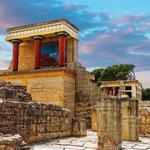
MINOAN PALACE OF KNOSSOS
Knossos is the most important archeological site on Crete. A pre-Greek Bronze Age culture and the first maritime power in the Mediterranean, the Minoans were named after the legendary King Minos. Knossos, near the city of Heraklion, is believed to have been the palace of King Minos. The Minoan Palace is a monumental residential complex that centers on a vast courtyard, where it seems they staged "Bull-Leaping," an activity that involved running towards a bull, grabbing it by the horns, and somersaulting over it. Knossos was abandoned around 1450 BC. Archaeologists are not sure why-it may have been a catastrophic earthquake following the volcanic explosion on Santorini, or perhaps Crete was ravaged by invaders. Whatever the cause, the Minoans completely disappeared.
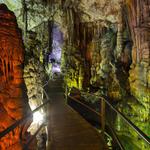
DIKTAION (PSYCHRO) CAVE
As you wander around Crete, you'll no doubt come across tales of the ancient Gods, their duties, lives, and origins. Considered the most important Greek god, Zeus was the god of the sky, thunder, and the king of all other gods and men. It's in Diktaion Cave that this famous god was brought forth for all humanity. Legends aside, the Diktaion Cave is considered one of the best of the 4,500 caves and sinkholes found throughout Crete. Its cool environs are a pleasant escape from the sun and heat of Crete. You'll pass through five antechambers as you make your way down deep into the earth. At the bottom of the cave is a glass-calm lake surrounded by immense stalactites and stalagmites. Across the lake in a small chamber is the area where Zeus was apparently born. This high area is mostly flat and is the breadbasket of the island, with orchards and extensive farms. Stop in a small village and grab a lunch consisting of the fresh, local produce capped off with a cold beverage.
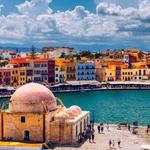
CHANIA
Chania is the main town in Western Crete and was the capital of the island until 1971 when it moved to Heraklion. Overlooking the Aegean Sea and backed by the White Mountains, which are snow-capped in winter, the old town's appearance dates from the centuries spent under Venice (1204-1645). Chania is a lovely place to explore on foot. A warren of romantic alleys with pastel-colored buildings enclosed within the remains of 16th-century defensive walls, the town extends to a pretty fishing harbor. The Municipal Market, built in 1911, is worth a look for its fresh seasonal produce and gifts such as Cretan cheese and honey. Chania has an airport (12 kilometers northeast of town on Akrotíri peninsula) and is served by regular ferries from Athens' port, Piraeus. It makes a good base for visiting the beaches of Elafonissi and Balos, and hiking the Samaria Gorge.
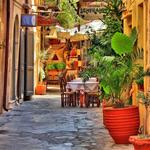
CHANIA | OLD TOWN
Explore the small local shops along the busy harbor and sample the offerings at its wonderful cafés, tavernas, and bakeries. The market was built in 1911. Vendors sell traditional Cretan products, including meat, fish, fresh seasonal produce, cheeses, olives, and spices, as well as souvenirs and handmade goods. The Venetian part of town, known as Topanas, used to be Catholic where the rulers from Venice established and built aristocratic mansions and beautiful churches between 1253 and 1645. The cobblestone alleys and the colorful passages of Topanas is now the place where the most exclusive boutique hotels have opened their doors, restoring the impressive Venetian palazzi in the district. Also located along the harbor front is Firkas Fortress, erected by the Venetians in 1629 as the city’s primary defense against invaders. Today, the fortress houses the Maritime Museum of Crete where visitors can see a broad range of nautical objects and artifacts.

CHANIA | BEACHES
Chania has a number of beaches! Here's a list if you'd like to explore: Balos This is a day trip by boat. While relatively close to Chania, Balos Lagoon and beach are a bit challenging to reach but well worth the effort. With its crystal turquoise waters, pink-tinged sand and dramatic rocky cliffs, Balos is easily the island’s most photogenic beach. You’ll need to take a ferry from Kissamos. Once you arrive, you’ll have the day to spend swimming and snorkeling in the warm, shallow water and strolling the beaches. Koum Kapi The most secluded beach in town. Elafonissi Beach A stunning beach with pink sand and crystal clear, shallow water. About a 1.5 hour drive through the mountains from Chania. Almyrida Beach This one has two nice sandy beaches with shallow water. They are separated by a small rocky pier peninsula with a small white chapel. It's very popular for water sports and windsurfing. Kalathas Beach Beautiful sandy beach with shallow water. Great for children.
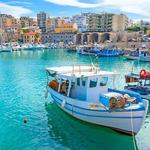
HERAKLION
Heraklion is the island's capital and a pleasant surprise for first-time visitors. The Old Town is a maze of lovely pedestrian streets lined with shops and restaurants. Huge trees provide ample shade in the squares, where you can linger over a coffee for hours at an outdoor café. Heraklion is also a base for visiting Knossos and exploring central Crete. Like many of Crete's finest coastal towns, it gained its present layout under the Venetians, who ruled from 1204 to 1669, a period which saw a considerable cultural flowering on the island, producing artists such as El Greco, from Fódele, near Heraklion. Many tourists start their trip in Heraklion, which has an international airport (5 kilometers east of town), and a ferry port with service to Athens' port, Piraeus, as well as several other Greek Islands. You can also visit Santorini on a day trip from Heraklion.
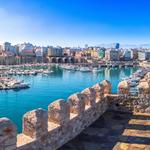
HERAKLION | OLD TOWN
Heraklion grew up around the sea, and still today, the old town focuses on the harbor. Fishing boats line the shore, where a walkway runs along the waterfront. Across the road but fronting the harbor are the Venetian Arsenals, easily recognizable by the stone facade and huge archways. This is where the Venetians repaired their ships. To the west of the harbor, the scenic promenade stretches along the sea and is lined with seafood restaurants. The Old Town is protected by a circuit of massive defensive walls, which have been demolished in parts. Inside, its pedestrian-only streets are lined by aristocratic buildings, churches, and boutiques, and open onto leafy squares with fountains and busy cafés.
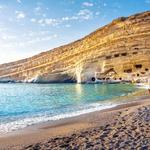
HERAKLION | DAY TRIPS
Matala is a resort/village 75 kilometers southwest of Heraklion. It has a long and wide stretch of beach that is protected on two sides by rocky headlands, creating a calm, clear beach, perfect for swimming. On one side, the rock face is riddled with caves, which makes this one of the most unique beaches to visit in Crete. The other side is home to restaurants that overlook this beautiful stretch of sand and the bay. Matala is one of the most visited resorts on Crete's remote south coast. It is more of a day-trip destination and does not have much by way of seaside accommodation. Agios Nikolaos is a small, but beautiful town. Highlights include a stroll along Lake Voulismeni (a small sweetwater lake connected to the sea), with many waterfront cafés and restaurants. According to Greek mythology, this was where Athena and Artemis would bathe. A walk around the point from the port to Kitroplatia beach takes you past two famous statues- the Horn of Almathea and the Abduction of Europa.
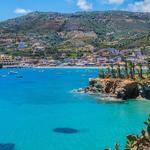
HERAKLION | BEACHES
Vathianos Kampos Beach This long sandy beach is located 15 kilometers from the center of Heraklion. The most organized area is in front of the Arina Beach Resort. It has umbrellas, sunbeds, and great beach bars. Ammoudara Beach Organized sandy beach and clean, but deep waters and sometimes windy. Amnissos Beach This is a very well-organized beach with all the necessary amenities. It’s sandy and exposed to northern winds. Kokkini Hani Beach Organized sandy beach, crystal-clear waters. Super popular among tourists.
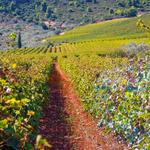
HERAKLION | WINERIES
Heraklion is home to more than 15 wineries, most of them open to the public. They offer all kinds of wine sampling and food pairing experiences. Agelakis Winery One of the most unique. Surrounded by vineyards and olive groves, this stands on the edge of the Thrapsano village. Boutari Winery One of Crete’s better-known wineries. It’s best to reserve in advance. Domaine Gavalas Aspires to create a winemaking trend that puts the environment above anything else. Prioritizes quality over quantity. Lyrarakis Winery Surrounded by vineyards and the Lassithi mountains. Silva Daskalaki Winery An ideal stop if you are heading to Matala. You'll love the feeling of this rural area with its many olive groves. Stilianou Winery In the heart of where once Minoan vineyards stood and just south of Knossos in the village of Kounavoi, Iannis Stilianou cultivates in 7 private acres of organic vineyards the local grape varieties.
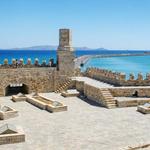
HERAKLION | HISTORICAL SITES
Lion’s Square This is where the Morosini Fountain is located. It was built by the Venetians with the purpose of providing drinking water to the city. Through a complex mechanism of altitude differences, the water would naturally flow all the way to the mouths of the lions. Venetian Fort of Koules Dating from the early 16th century. Climb the stairs to the roof for incredible views out to sea and over the harbor towards town. Heraklion Archaeological Museum This museum contains 3,500 year old frescoes from Knossos. Its treasures cover more than 5,500 years of history. Historical Museum of Crete Traces 1,700 years of history on the island, from early Christian times to the modern era. You'll see religious icons, stone carvings, ceramics, textiles, and folk costumes from the Byzantine, Venetian, and Turkish periods. Cathedral of St. Minas Dedicated to the patron saint of Heraklion. This is the largest church in Crete and is renowned for its extensive iconography.
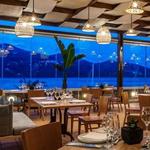
RESTAURANTS
Rethymno - Artisanal coffee at Brew Your Mind - Gyro at Souvlaki Nikos - Marouvas for traditional Greek Heraklion - Chagiati is highly recommended, but you need to arrive early or make a reservation. - Hairi is a newer Cretan restaurant with a chef focusing on local ingredients and traditional food. - Kirkor is in the center of the square. Try their own bougatsa. Chania - Recommended for breakfast is Bougatsa Iordanis. This old, traditional pastry shop, a few steps from the Public Market, has been crafting bougatsa since 1924. Bougatsa is a traditional pastry made of phyllo dough, filled with local goat cheese, and topped with cinnamon and sugar. - The area known as Neoria, or the Arsenals (opposite the sea where yachts dock) is lined with restaurants that are a good option for lunch. You can also find a lunch spot at the Municipal Market of Chania. - Chania restaurants along the Venetian port are good for dinner, as are the restaurants on the pedestrian Chatzimichali Ntaliani lane.